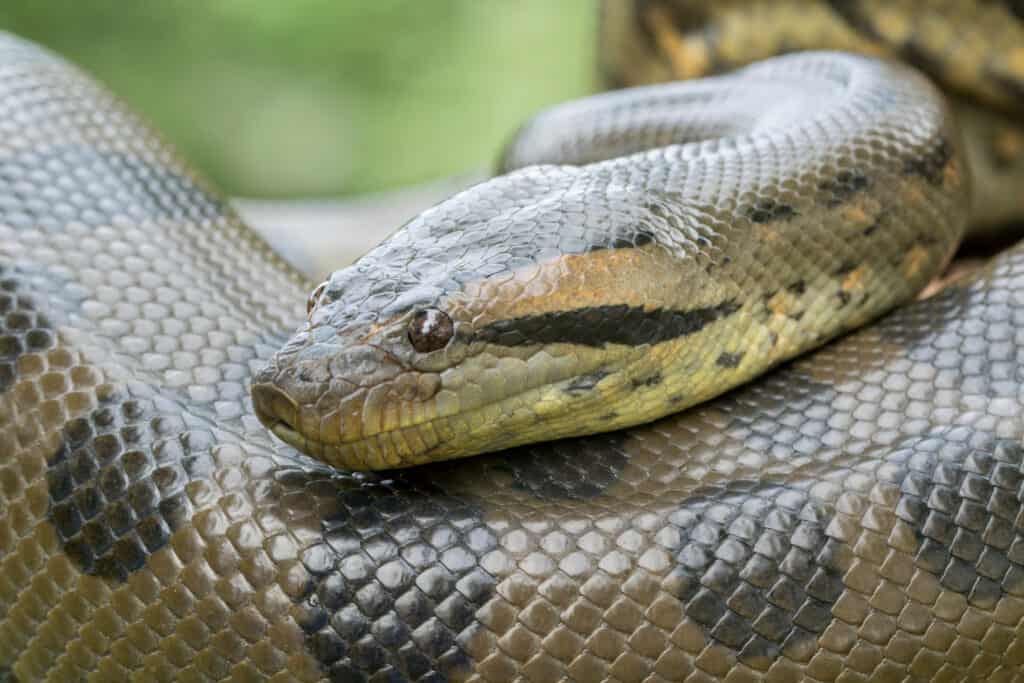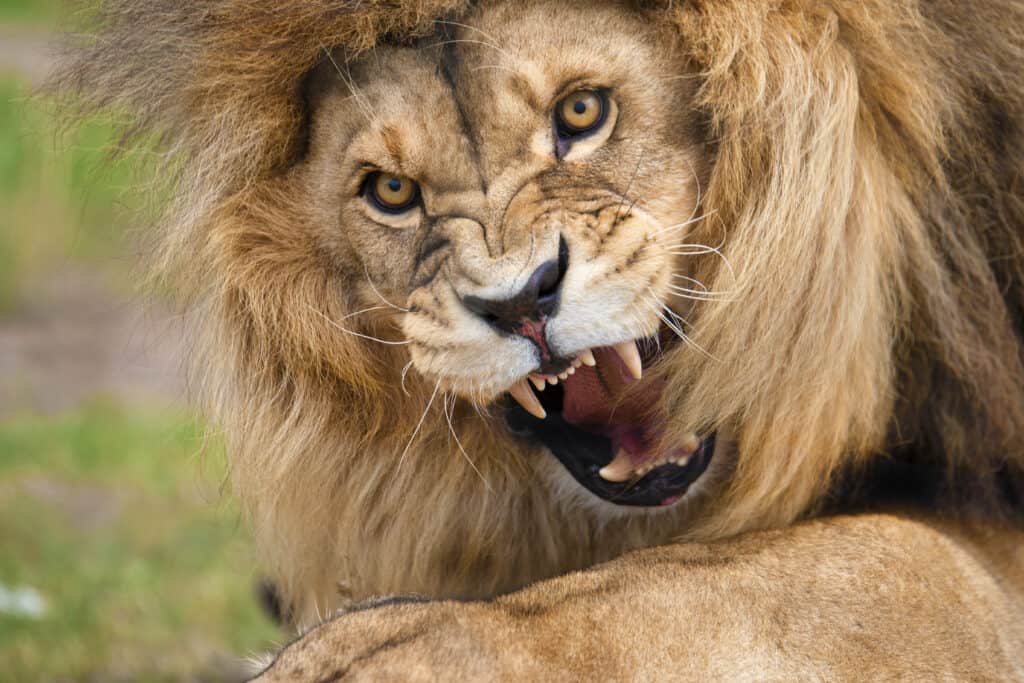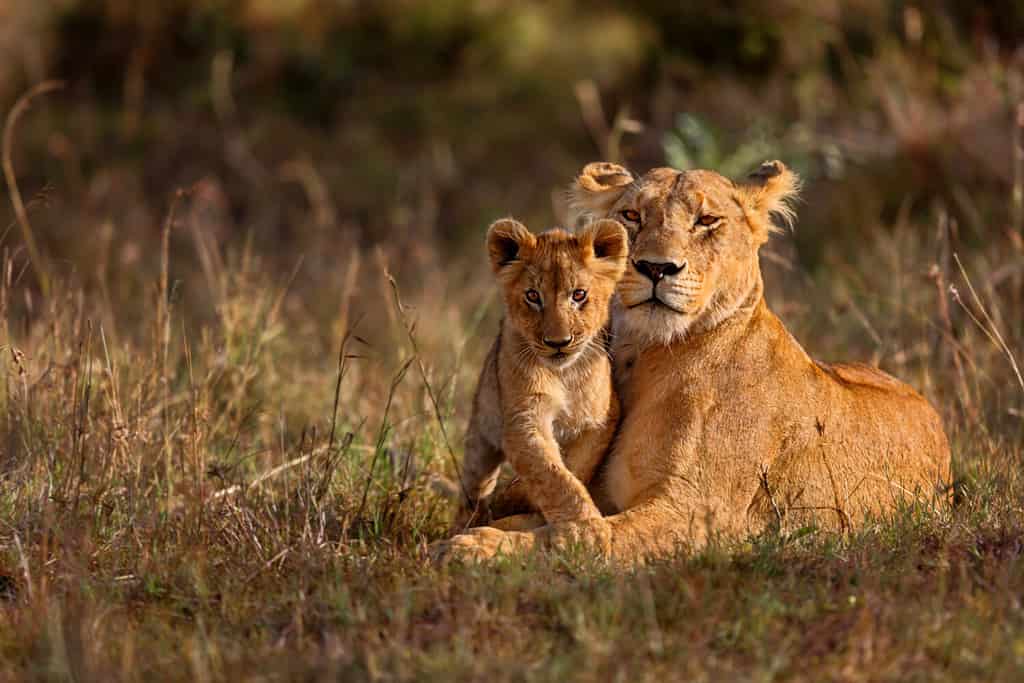Key Point
- Green anacondas reach top speeds of 5 mph on land and 10 mph underwater.
- Lions can easily catch up with the large constrictor with an impressive top speed of 50 mph on land.
- Lions have powerful forelegs, 3-inch-long canines, and jaws designed for pulling down and killing prey.
It’s an animal showdown! The green anaconda against the mighty lion.
Green anacondas are strong, muscular snakes even thicker than other boas. They have large heads, thick necks, and a big black stripe that runs from the eye to the jaw. Lions are the second largest wild cat and have one of the highest percentages of muscles among mammals.
So, what happens when a slender muscly snake tries to turn a bulky lion into a meal? Let’s find out. Follow along to discover who will emerge victorious in this anaconda vs. lion battle.
| Battle Factors | Anaconda | Lion |
|---|---|---|
| Size | 30 feet long 1-foot diameter 550 pounds | 3 to 4 feet tall 8 to 10 feet in length 330 to 550 pounds |
| Speed | 5 mph | 50 mph (for short distances) |
| Carnivorous characteristics | Apex predator Eats deer, birds, and own species Strong jaws suffocate prey Jaw detaches to swallow prey | Ambush hunter Hunts with group Causes prey to panic Exhausts prey with fast pursuit |
| Top advantages | Strong muscular body Stealth Comfortable navigating rivers | Strength Stealth |
Anaconda: Characteristics And Fighting Advantages

These snakes are just 2 feet long at birth. However, once they grow up, green anacondas can be 30 feet long and weigh as much as 550 pounds!
©Mark_Kostich/Shutterstock.com
Who exactly is fighting in this anaconda vs. lion battle? There are four species of anaconda: the Bolivian, the green, the yellow, and the dark-spotted anacondas. The largest species, the green anaconda, is the one fighting today. These snakes are just 2 feet long at birth. However, once they grow up, green anacondas can be 30 feet long and weigh as much as 550 pounds! And the females are much larger than the males.
These green giants slither throughout the Amazon Rainforest—seeking out areas that flood seasonally. Once the dry season comes around, they have to burrow into the mud or go on the hunt for more water.
Anacondas love living in slow-moving streams, marshes, and swamps.
Water Assassin
One of the anaconda’s favorite ways to take down prey is by drowning them. They can survive up to 10 minutes underwater without a problem, which is plenty of time to drown a small bird, rodent, or even jaguar.
It’s easy for green anacondas to find prey underwater. Their eyes and nose are on the top of their head, which helps them breathe and see while swimming. If the lion is hiding out below the surface, this snake will know right away.
Deadly Squeeze
If the anaconda can wrap around the lion, its deadly squeeze could be enough to win this battle. As members of the boa constrictor family, anacondas don’t need to use venom to kill their prey. Instead, they overwhelm the prey’s circulatory system. The harder the anaconda squeezes its coil around the animal, the more difficult it is for the heart to pump blood outward.
Expert Hunter
In other animal battles, the lion had the advantage of being the only skilled hunter. But that’s not the case here. This is an anaconda vs. lion showdown, and both carnivorous creatures are expert predators. These snakes regularly kill caiman, capybara, wild pigs, small deer, and jaguars. Sometimes they even kill and eat members of their own species.
Lion: Characteristics And Fighting Advantages

They have powerful forelegs, 3-inch-long canines, and jaws designed for pulling down and killing prey.
©Shawn Levin/Shutterstock.com
After tigers, lions are the biggest member of the cat family. Lions are also the only cat group that regularly lives in a social setting or a pride. A pride of lions usually has one dominant male and multiple fierce lionesses. The anaconda will only be fighting the one dominant male lion today.
Designed To Kill
Adult male lions are much bigger than females. An average male weighs around 420 pounds and females weigh around 280 pounds. They have powerful forelegs, 3-inch-long canines, and jaws designed for pulling down and killing prey. Lions have also mastered the art of slow strangulation.
As Fast As A Car
Green anacondas reach top speeds of 5 mph on land and 10 mph underwater. Lions can easily catch up with the large constrictor with an impressive top speed of 50 mph on land.
When these wild cats go after prey like zebras or antelopes, they fail 30% of the time. But the anaconda’s speed isn’t close to the steady clip of a hooved animal. In an anaconda vs. lion chase, the lion can catch the long green competitor within seconds.
Who Wins The Fight?
The lion wins! Hiding in the brush of the savannah, the lion waits for the perfect moment to attack. As soon as the snake is within striking distance, the dominant male lion pounces and drives its sharp 3-inch-long canines into the snake’s green scales. Then the king of the jungle tears the snake apart with its powerful paws and sharp claws.
Did the anaconda ever stand a chance? Nope. The snake had no hope against a healthy adult lion. The green beast might be able to take down slender jaguars, but large lions are another story. This animal battle is a win for team kitty! In an anaconda vs. lion battle, the lion is the champion.
Do Lions Actually Eat Snakes?

Sometimes, baby lions will practice hunting on small animals like lizards, snakes, and birds.
©Maggy Meyer/Shutterstock.com
Lions are the top predators in their habitat, meaning that they hunt and eat other animals to survive. They mainly feed on large mammals such as antelopes, zebras, wildebeests, buffalo, and even rhinos. Lions also will sometimes take down smaller prey such as rodents or reptiles like snakes. When hunting larger game, lions typically hunt together in groups known as prides. Each pride takes turns chasing down its target while the others follow behind, ready to pounce if necessary.
One reason that lions aren’t a big fan of eating snakes is that snakes aren’t worth the bother. Lions need a lot of food! So, they aim for larger prey. A single lion needs to eat between 11 and 15 pounds of food per day. Sometimes, when food is scarce, they will go hungry for up to a week. Then, when they finally do get a meal, they will eat up to a quarter of their own body weight. That is one big dinner!
The photo featured at the top of this post is ©
Thank you for reading! Have some feedback for us? Contact the AZ Animals editorial team.






